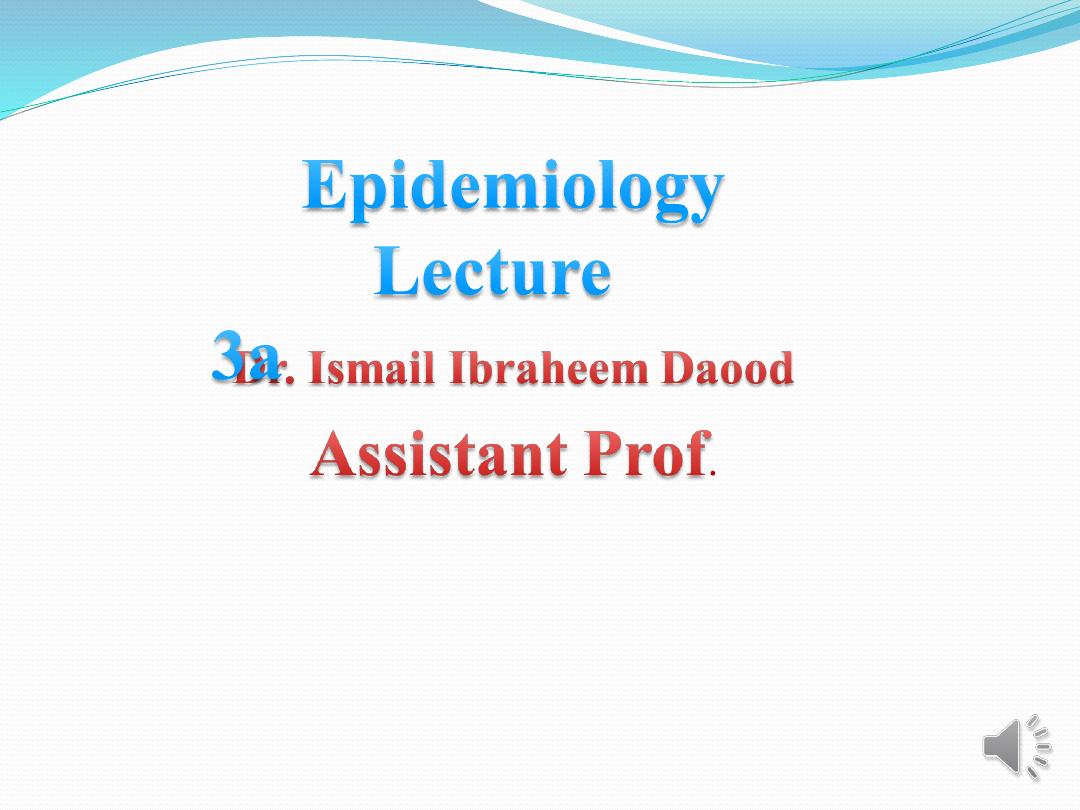
Nursing College – Mosul
University

Reservoir
is the natural location of the
organism. This may be either an animate or in
animate location.
Source is immediate location from which the
infecting organisms has been transmitted.
The natural habitat or source of disease
producing organisms is called reservoir .
As part of their infectious cycle, all pathogens
exist at least temporarily on or more natural
environment are termed reservoirs of infection
from which they are transmitted to humans

Microorganisms live, survive and
transmitted to another human (host)
there are three type of reservoirs :
1-Human reservoir
2-Animals reservoir
3- Environment Reservoirs

Human Reservoir
:
Microbes cause infectious diseases are
:
1-
Bacteria (such as Salmonella,
Streptococcus, Clostridium etc.)
2- Viruses (as HIV, HBV, Poxvirus etc.)
3- Fungi (as Aspergillus, Candida etc.)
4- Parasites (as Toxoplasma, Giardia,
or protozoa, and Helminthes
. etc.

a- Symptomatic illness or human disease.
e.g. mumps, measles, smallpox , viruses
Human were only reservoir , they were always
symptomatic or clinical symptoms.
b- Subclinical infection.
e.g. acute carries of Tb disease or Hepatitis carrier
the HBV, HIV, HSV.
c- Chronic carrier.
A person with a symptomatic infection that can
transmitted to another susceptible person or animal.
Carriers can transmitted the disease to another by
more than one a ways and cause disease to health
person e.g. : HBV, HIV, typhus, cholera.

Carrier :
Carrier defined as a person who is colonized
with potential pathogen, but who is not ill, and
can transmit that organism to other or without
sign and symptoms that carrier divided into :
1- According to the spectrum of disease.
(clinical course of the disease) into :
a- Incubation period as Diphtheria, mumps,
b- Clinical sign and symptoms.
c- Convalescent stage e.g. hepatitis.
d- Post convalescent stage e.g. typhoid.

2- According to type of disease.
a- Healthy carrier when a person harbor's the
microorganisms without any sign and symptoms.
Give no history of the disease before and give no
history contact person of that disease.
e.g. : primary pulmonary Tb.
b- Contact carrier
when a person harbor the microorganisms
without any sign and symptoms. Give no history
of the disease before but give history of contact
person of that disease. e.g. cholera, HAV, measles

3- According to period of caring the microbe.
a-Transient carrier:
(1-2) weeks
e.g.
measles, mump
b-Temporary carrier
:
(few week - 6months)
e.g. Diphtheria meningococcal, meningitis.
c- Chronic carrier:
(few months - few years)
e.g. Cholera , typhoid , paratyphoid, HBV.
d-
Permanent (closed) carrier:
microorganisms remain in tissue and tissue
fluid e.g. Brucellosis , HSV.

4- According to route of exit of microbe.
a- Respiratory carrier:
- upper respiratory carrier such as Diphtheria,
meningitis.
- lower respirator carrier such as pneumonia,
nocardiasis
b- Urinary tract carrier:
e.g. : typhoid
c- Intestinal carrier:
e.g Cholera, Shigella bacilli dysentery
d- Oral carrier:
e.g. : AIDS, (HIV), venereal disease as
gonorrhea, Syphilis.

e- Glandular carrier.
1- milk . e.g. : Brucellosis
2- Salivary gland e.g. : Toxoplasmosis
f- Tran placenta carrier.
e.g. German measles, venereal disease.
g- Mechanical carrier.
e.g. 1- insect in malaria.
2- blood transfusions in HIV, HBV,
3- Syringe in HIV, HBV
h- Open lesion carrier.
such as skin in Staphylococcus aureus by
mucous membrane, in venereal disease
.

2- Animals reservoirs : (zoonoses)
Many diseases were very important as
reservoir of infectious agents exist in
animals such as plague, rabies, malaria,
Toxoplasmosis, Salmonellosis, Giardia,
Entameoba,
that
can
transmitted
to
humans, but primarily exist in other
animals are called " Zoonotic " disease
.

Types of animals reservoirs :
a- Insect in malaria reservoir is the anopheles
mosquito
b- low vertebrate.
e.g. : Rabies in dogs.
Toxoplasma in cats.
c- high vertebrate
e.g. : Brucellosis in sheep.
Brucellosis in cow.

d- Birds: e.g. Sal. typhimurum,
Cryptococcus.
e- Rodents: e.g. : endemic typhus,
Bubonic plague.
f-Domestic and wild animals :
e.g. : Brucellosis in sheep and cow.
Toxophsmosis in cat birds.
Campylobacter cause diarrhea.

3- Environment Reservoirs :
Some pathogens have environmental reservoirs
and factors in causative disease. Such as :
biological, physical, social, economical, and
habitual.
Type of environmental reservoirs :
• Water:
is very important to transmitted high
disease and contain high infectious pathogenic
microorganisms. e.g. Cholera , Streptococcus ,
Pseudomonas , also eggs & larva of parasites.

• Soils :
• Hard soil, Spore forming microorganisms (r\e.g. Cl tetani
that cause tetanus disease.Cl welchii cause Gasgangreen.
• Soft soil: such as house garden (e.g. egg larva of
Ankylostoma warm, Oocyst of Toxoplasma parasites. Also
Salmonella typhi, E .coli, HAV.
Reservoirs and Sources are responsible for distribution of
disease. The reservoir is distinguished from the source of
infection, the individual or object from which an infection is
actually acquired. E.g. Reservoir and source for N
gonorrhea are the same that is human.

•Water reservoir
a.Tap water e.g. cholera
b.Swimming water e.g. Tinea saginata, T. barbi,
T. capitis, Staph. aureus, and Pseudomonas

Transmission :
A successful pathogen must some how be transmitted
from its reservoir to the next susceptible host. Diseases
can be transmitted by more than one away that term
mode of transmission by :
A-Vertical transmission :
Vertical transmission is from mother to child in utero
or disease passed directly from a pregnant woman to
the fetus cross the placenta or in breast milk to
newborn.
e.g. : syphilis, rubella, (HIV/AIDS) disease
.
B-Horizontal Transmission :

B.
Horizontal Transmission
:
Direct contact
This is a major transmission route for spread of infections in hospital
and other health care as nosocomial infections- noso disease
a- person to person.
e.g. : Syphilis cause by Treponema pallidum
Gonococci = by N. gonorrhea. Hepatitis type
b- Infectious dose.
e.g. Bacillary dysentery cause by Shigella bacilli only (100
numbers) to make possible to cause the dysentery disease.
c- Sexual transmission disease (STD).
e.g. : Herpes by HSV-1 and HSV-2
AIDS by (HIV)
d- Skin to skin transmission
e.g. : wounded injury by Staphylococcus aureus , scabies.

- Indirect contact.
This is a common from for transmission of microbe
from an infected source to a susceptible host a
contaminated intermediate objects
a-Mechanical
Transfer of pathogens via inanimate objects such as
clothing, table tops, doorknobs, drinking glasses as
HAV, staphylococcus aureus contaminate his or hands
when touching asking infection or his colonized nose.
b- Biological.
This form of transmission is mediated by a variety of
invertebrate and vertebrate source as Mosquito,
Rodent, Tick.

c- Airborne : - sneezing and coughing can
transmitted microorganism in a fine spray.
- crowded rooms
- environment reservoirs by dust, soil
- droplet particle, sputum
d- Common vehicle.
as water, food etc.
